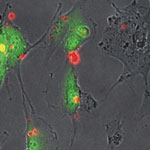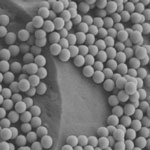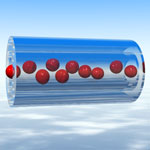Showing Spotlights 1897 - 1904 of 2782 in category All (newest first):
 In a nanotechnology risk assessment study published last year, researchers concluded that the costs associated with nanomaterial risk assessment in the United States alone could range anywhere from $249 million to $1.18 billion and might take decades to complete at current levels of investment in nano-hazard testing. While research in quantitative risk characterization of nanomaterials is crucially important, and no one advocates abandoning this approach, scientists and policy makers must face the reality that many of these knowledge gaps cannot be expected to be closed for many years to come - and decision making will need to continue under conditions of uncertainty. At the same time, current chemical-based research efforts are mainly directed at establishing toxicological and ecotoxicological and exposure data for nanomaterials, with comparatively little research undertaken on the tools or approaches that may facilitate near-term decisions. A group of scientists suggests that this situation requires a significant research program in a fundamental area of timely, yet informed decision making regarding the potential risks of nanomaterials. They highlight some of these issues as well as outline some of the currently available tools and approaches for decision making regarding the potential risks of nanomaterials.
In a nanotechnology risk assessment study published last year, researchers concluded that the costs associated with nanomaterial risk assessment in the United States alone could range anywhere from $249 million to $1.18 billion and might take decades to complete at current levels of investment in nano-hazard testing. While research in quantitative risk characterization of nanomaterials is crucially important, and no one advocates abandoning this approach, scientists and policy makers must face the reality that many of these knowledge gaps cannot be expected to be closed for many years to come - and decision making will need to continue under conditions of uncertainty. At the same time, current chemical-based research efforts are mainly directed at establishing toxicological and ecotoxicological and exposure data for nanomaterials, with comparatively little research undertaken on the tools or approaches that may facilitate near-term decisions. A group of scientists suggests that this situation requires a significant research program in a fundamental area of timely, yet informed decision making regarding the potential risks of nanomaterials. They highlight some of these issues as well as outline some of the currently available tools and approaches for decision making regarding the potential risks of nanomaterials.
Jan 20th, 2010
 Oncogenes are genes that are associated with the development of cancer - when mutated or expressed at high levels, they can help turn a normal cell into a tumor cell. Promising new chemotherapeutic strategies have therefore focused on suppressing oncogenes. One such approach is based on RNA interference (RNAi), a technique wherein small double-stranded RNA molecules can sequence-specifically inhibit the expression of targeted oncogenes. The idea here is that with the help of small interfering RNA (siRNA), key oncogenes that modulate signaling pathways and thereby regulate the behavior of malignant tumor cells can be manipulated. To harness the full potential of this approach, the prime requirements are to deliver the siRNA molecules with high selectivity and efficiency into tumor cells and to monitor both siRNA delivery and the resulting knockdown effects at the single-cell level.
Oncogenes are genes that are associated with the development of cancer - when mutated or expressed at high levels, they can help turn a normal cell into a tumor cell. Promising new chemotherapeutic strategies have therefore focused on suppressing oncogenes. One such approach is based on RNA interference (RNAi), a technique wherein small double-stranded RNA molecules can sequence-specifically inhibit the expression of targeted oncogenes. The idea here is that with the help of small interfering RNA (siRNA), key oncogenes that modulate signaling pathways and thereby regulate the behavior of malignant tumor cells can be manipulated. To harness the full potential of this approach, the prime requirements are to deliver the siRNA molecules with high selectivity and efficiency into tumor cells and to monitor both siRNA delivery and the resulting knockdown effects at the single-cell level.
Jan 19th, 2010
 In characterizing materials, especially live biological specimen such as cells, it is important not only to be able to explore the surface but also any subsurface structures and properties - without damaging or destroying the sample and for hard and soft materials alike. For example, many synthesized nanoparticles can readily get inside a cell. Therefore studying the cell surface, while useful, can provide little or no knowledge about the particles hidden in the interior of the cell. Another example is the detection of nanoscale defects in nanofabricated structures such as those made by electron beam lithography; or the detection of embedded cracks and voids in nanocomposite materials. Researchers have now shown that an atomic force microscope can obtain a range of surface and subsurface information by making use of the nonlinear nanomechanical coupling between the probe and the sample.
In characterizing materials, especially live biological specimen such as cells, it is important not only to be able to explore the surface but also any subsurface structures and properties - without damaging or destroying the sample and for hard and soft materials alike. For example, many synthesized nanoparticles can readily get inside a cell. Therefore studying the cell surface, while useful, can provide little or no knowledge about the particles hidden in the interior of the cell. Another example is the detection of nanoscale defects in nanofabricated structures such as those made by electron beam lithography; or the detection of embedded cracks and voids in nanocomposite materials. Researchers have now shown that an atomic force microscope can obtain a range of surface and subsurface information by making use of the nonlinear nanomechanical coupling between the probe and the sample.
Jan 18th, 2010
 One important aspect of clothing comfort is thermo-physiological comfort. By adjusting the transport of heat and moisture through a fabric, thermo-physiological comfort can keep people comfortable with regard to temperature and moisture. Some hydrophobic fabrics have deficiencies in this area. Take wool. Wool is one of the best insulating fibers known to man - while at the same time being light and soft. The quality that distinguishes wool fibers is the presence of a fatty, water-repellent outer layer that surrounds each fiber. Therefore, the water absorption and sweat venting properties of wool fiber are not very good, which affects the wearing comfort of wool textiles. The wool hydrophobic surface layer is also a barrier to anticrease finishing, dyeing, and grafting of hydrophilic agents, which is an issue in trying to add smart functionalities to wool fabrics.
Researchers have now developed a simple method for fabricating environmentally stable superhydrophilic wool fabrics. They applied silica sols to natural wool fibers to form an ultrathin layer on the surface of the fibers.
One important aspect of clothing comfort is thermo-physiological comfort. By adjusting the transport of heat and moisture through a fabric, thermo-physiological comfort can keep people comfortable with regard to temperature and moisture. Some hydrophobic fabrics have deficiencies in this area. Take wool. Wool is one of the best insulating fibers known to man - while at the same time being light and soft. The quality that distinguishes wool fibers is the presence of a fatty, water-repellent outer layer that surrounds each fiber. Therefore, the water absorption and sweat venting properties of wool fiber are not very good, which affects the wearing comfort of wool textiles. The wool hydrophobic surface layer is also a barrier to anticrease finishing, dyeing, and grafting of hydrophilic agents, which is an issue in trying to add smart functionalities to wool fabrics.
Researchers have now developed a simple method for fabricating environmentally stable superhydrophilic wool fabrics. They applied silica sols to natural wool fibers to form an ultrathin layer on the surface of the fibers.
Jan 15th, 2010
 Experts and the public generally differ in their perceptions of technology risk. While this might be due to social and demographic factors, it is generally assumed by scientists who conduct risk research that experts' risk assessments are based more strongly on actual or perceived knowledge about a technology than lay people's risk assessments. Nevertheless, whether the risks are real or not, the public perception of an emerging technology will have a major influence on the acceptance of this technology and its commercial success. If the public perception turns negative, potentially beneficial technologies will be severely constrained as is the case for instance with gene technology. It is not surprising that a new study found that, in general, nanoscientists are more optimistic than the public about the potential benefits of nanotechnology. What is surprising though, is that, for some issues related to the environmental and long-term health impacts of nanotechnology, nanoscientists seem to be significantly more concerned than the public. Arguing that risk communication on nanotechnologies requires target-specific approaches, a group of researchers in Germany advocate the development of communication strategies that help people to comprehend nanotechnology, to differentiate between the fields of application and to gain an understanding of the cause and effect chains.
Experts and the public generally differ in their perceptions of technology risk. While this might be due to social and demographic factors, it is generally assumed by scientists who conduct risk research that experts' risk assessments are based more strongly on actual or perceived knowledge about a technology than lay people's risk assessments. Nevertheless, whether the risks are real or not, the public perception of an emerging technology will have a major influence on the acceptance of this technology and its commercial success. If the public perception turns negative, potentially beneficial technologies will be severely constrained as is the case for instance with gene technology. It is not surprising that a new study found that, in general, nanoscientists are more optimistic than the public about the potential benefits of nanotechnology. What is surprising though, is that, for some issues related to the environmental and long-term health impacts of nanotechnology, nanoscientists seem to be significantly more concerned than the public. Arguing that risk communication on nanotechnologies requires target-specific approaches, a group of researchers in Germany advocate the development of communication strategies that help people to comprehend nanotechnology, to differentiate between the fields of application and to gain an understanding of the cause and effect chains.
Jan 14th, 2010
 Emerging nanotechnology applications in the fields of medicine and biology often involve the use of nanoparticles for probing biological processes and structures or for constructing sophisticated nanoscale drug delivery mechanisms. Nanoparticles are already being used with dramatic success in biomedical applications. However, relatively little is known about the potential biological risks from these nanoparticle applications inside the body. The identity of nanoparticles in a biological medium, in terms of their interaction with that medium, is largely determined by the proteins that dress the particles. Since many of the toxic and therapeutic uses of nanoparticles involve the introduction of nanoparticles into the bloodstream of humans and other animals, it is particularly important to know how nanoparticles interact with blood proteins. New research performed in the Polymers Division at the National Institute of Standards and Technology (NIST) directly addresses this issue and explores the effects of nanoparticle size (5nm to 100nm) and a whole range of important blood proteins.
Emerging nanotechnology applications in the fields of medicine and biology often involve the use of nanoparticles for probing biological processes and structures or for constructing sophisticated nanoscale drug delivery mechanisms. Nanoparticles are already being used with dramatic success in biomedical applications. However, relatively little is known about the potential biological risks from these nanoparticle applications inside the body. The identity of nanoparticles in a biological medium, in terms of their interaction with that medium, is largely determined by the proteins that dress the particles. Since many of the toxic and therapeutic uses of nanoparticles involve the introduction of nanoparticles into the bloodstream of humans and other animals, it is particularly important to know how nanoparticles interact with blood proteins. New research performed in the Polymers Division at the National Institute of Standards and Technology (NIST) directly addresses this issue and explores the effects of nanoparticle size (5nm to 100nm) and a whole range of important blood proteins.
Jan 13th, 2010
 A very promising field of nanomotor research are DNA nanomachines. These are synthetic DNA assemblies that switch between defined molecular shapes upon stimulation by external triggers. They can be controlled by a variety of methods that include pH changes and the addition of other molecular components, such as small molecule effectors, proteins and DNA strands. Researchers have now designed and built a simple DNA machine that is capable of continuous rotation with controlled speed and direction - a function that might be very useful for example for molecular transport. This machine is driven by an externally controlled electric field. When this field is oscillated between four directions, it continuously reorients a rotor DNA that is asymmetrically attached to a DNA axle.
A very promising field of nanomotor research are DNA nanomachines. These are synthetic DNA assemblies that switch between defined molecular shapes upon stimulation by external triggers. They can be controlled by a variety of methods that include pH changes and the addition of other molecular components, such as small molecule effectors, proteins and DNA strands. Researchers have now designed and built a simple DNA machine that is capable of continuous rotation with controlled speed and direction - a function that might be very useful for example for molecular transport. This machine is driven by an externally controlled electric field. When this field is oscillated between four directions, it continuously reorients a rotor DNA that is asymmetrically attached to a DNA axle.
Jan 12th, 2010
 In many biomedical applications, protein nanotubes present several advantages over nanospheres. The layer-by-layer (LbL) deposition technique for the preparation of protein nanotubes has attracted considerable attention because of their potential nanotechnology applications in enzymatic nanocatalysts, bioseparation nanofilters, and targeting nanocarriers. A drawback is that in template synthesis the extraction process often results in physical deformation of the nanotubes. Researchers in Japan have now developed a new procedure using specific solvent and freeze-drying technique. They describe for the first time molecular capturing properties of protein nanotubes with a controllable affinity and size selectivity.
In many biomedical applications, protein nanotubes present several advantages over nanospheres. The layer-by-layer (LbL) deposition technique for the preparation of protein nanotubes has attracted considerable attention because of their potential nanotechnology applications in enzymatic nanocatalysts, bioseparation nanofilters, and targeting nanocarriers. A drawback is that in template synthesis the extraction process often results in physical deformation of the nanotubes. Researchers in Japan have now developed a new procedure using specific solvent and freeze-drying technique. They describe for the first time molecular capturing properties of protein nanotubes with a controllable affinity and size selectivity.
Jan 11th, 2010
 In a nanotechnology risk assessment study published last year, researchers concluded that the costs associated with nanomaterial risk assessment in the United States alone could range anywhere from $249 million to $1.18 billion and might take decades to complete at current levels of investment in nano-hazard testing. While research in quantitative risk characterization of nanomaterials is crucially important, and no one advocates abandoning this approach, scientists and policy makers must face the reality that many of these knowledge gaps cannot be expected to be closed for many years to come - and decision making will need to continue under conditions of uncertainty. At the same time, current chemical-based research efforts are mainly directed at establishing toxicological and ecotoxicological and exposure data for nanomaterials, with comparatively little research undertaken on the tools or approaches that may facilitate near-term decisions. A group of scientists suggests that this situation requires a significant research program in a fundamental area of timely, yet informed decision making regarding the potential risks of nanomaterials. They highlight some of these issues as well as outline some of the currently available tools and approaches for decision making regarding the potential risks of nanomaterials.
In a nanotechnology risk assessment study published last year, researchers concluded that the costs associated with nanomaterial risk assessment in the United States alone could range anywhere from $249 million to $1.18 billion and might take decades to complete at current levels of investment in nano-hazard testing. While research in quantitative risk characterization of nanomaterials is crucially important, and no one advocates abandoning this approach, scientists and policy makers must face the reality that many of these knowledge gaps cannot be expected to be closed for many years to come - and decision making will need to continue under conditions of uncertainty. At the same time, current chemical-based research efforts are mainly directed at establishing toxicological and ecotoxicological and exposure data for nanomaterials, with comparatively little research undertaken on the tools or approaches that may facilitate near-term decisions. A group of scientists suggests that this situation requires a significant research program in a fundamental area of timely, yet informed decision making regarding the potential risks of nanomaterials. They highlight some of these issues as well as outline some of the currently available tools and approaches for decision making regarding the potential risks of nanomaterials. 
 Subscribe to our Nanotechnology Spotlight feed
Subscribe to our Nanotechnology Spotlight feed





